�
Part I
Introduction
I.1 What Is Mathematics About?
It is notoriously hard to give a satisfactory answer to
the question, “What is mathematics?” The approach of
this book is not to try. Rather than giving a definition of
mathematics, the intention is to give a good idea of what
mathematics is by describing many of its most impor-
tant concepts, theorems, and applications. Nevertheless,
to make sense of all this information it is useful to be
able to classify it somehow.
The most obvious way of classifying mathematics is by
its subject matter, and that will be the approach of this
brief introductory section and the longer section enti-
tled some fundamental mathematical definitions
[I.3]. However, it is not the only way, and not even obvi-
ously the best way. Another approach is to try to clas-
sify the kinds of questions that mathematicians like to
think about. This gives a usefully different view of the
subject: it often happens that two areas of mathematics
that appear very different if you pay attention to their
subject matter are much more similar if you look at the
kinds of questions that are being asked. The last sec-
tion of part I, entitled the general goals of mathe-
matical research [I.4], looks at the subject from this
point of view. At the end of that article there is a brief
discussion of what one might regard as a third classi-
fication, not so much of mathematics itself but of the
content of a typical article in a mathematics journal. As
well as theorems and proofs, such an article will contain
definitions, examples, lemmas, formulas, conjectures,
and so on. The point of that discussion will be to say
what these words mean and why the different kinds of
mathematical output are important.
1 Algebra, Geometry, and Analysis
Although any classification of the subject matter of
mathematics must immediately be hedged around with
qualifications, there is a crude division that undoubtedly
works well as a first approximation, namely the division
of mathematics into algebra, geometry, and analysis. So
let us begin with this, and then qualify it later.
1.1 Algebra versus Geometry
Most people who have done some high-school mathe-
matics will think of algebra as the sort of mathemat-
ics that results when you substitute letters for num-
bers. Algebra will often be contrasted with arithmetic,
which is a more direct study of the numbers themselves.
So, for example, the question, “What is 3 × 7?” will be
thought of as belonging to arithmetic, while the ques-
tion, “If x + y = 10 and xy = 21, then what is the
value of the larger of x and y?” will be regarded as a
piece of algebra. This contrast is less apparent in more
advanced mathematics for the simple reason that it is
very rare for numbers to appear without letters to keep
them company.
There is, however, a different contrast, between alge-
bra and geometry, which is much more important at an
advanced level. The high-school conception of geometry
is that it is the study of shapes such as circles, trian-
gles, cubes, and spheres together with concepts such
as rotations, reflections, symmetries, and so on. Thus,
the objects of geometry, and the processes that they
undergo, have a much more visual character than the
equations of algebra.
This contrast persists right up to the frontiers of mod-
ern mathematical research. Some parts of mathemat-
ics involve manipulating symbols according to certain
rules: for example, a true equation remains true if you
“do the same to both sides.” These parts would typically
be thought of as algebraic, whereas other parts are con-
cerned with concepts that can be visualized, and these
are typically thought of as geometrical.
However, a distinction like this is never simple. If you
look at a typical research paper in geometry, will it be full
of pictures? Almost certainly not. In fact, the methods
used to solve geometrical problems very often involve
a great deal of symbolic manipulation, although good
powers of visualization may be needed to find and use
2
I.
Introduction
these methods and pictures will typically underlie what
is going on. As for algebra, is it “mere” symbolic manip-
ulation? Not at all: very often one solves an algebraic
problem by finding a way to visualize it.
As an example of visualizing an algebraic problem,
consider how one might justify the rule that if a and
b are positive integers then ab = ba. It is possible to
approach the problem as a pure piece of algebra (per-
haps proving it by induction), but the easiest way to con-
vince yourself that it is true is to imagine a rectangular
array that consists of a rows with b objects in each row.
The total number of objects can be thought of as a lots
of b, if you count it row by row, or as b lots of a, if you
count it column by column. Therefore, ab = ba. Similar
justifications can be given for other basic rules such as
a(b + c) = ab + ac and a(bc) = (ab)c.
In the other direction, it turns out that a good way
of solving many geometrical problems is to “convert
them into algebra.” The most famous way of doing this
is to use Cartesian coordinates. For example, suppose
that you want to know what happens if you reflect a
circle about a line L through its center, then rotate it
through 40◦
counterclockwise, and then reflect it once
more about the same line L. One approach is to visualize
the situation as follows.
Imagine that the circle is made of a thin piece of wood.
Then instead of reflecting it about the line you can rotate
◦
it through 180
about L (using the third dimension). The
result will be upside down, but this does not matter if
you simply ignore the thickness of the wood. Now if you
look up at the circle from below while it is rotated coun-
terclockwise through 40
, what you will see is a circle
being rotated clockwise through 40
. Therefore, if you
then turn it back the right way up, by rotating about L
once again, the total effect will have been a clockwise
◦
rotation through 40
◦
◦
.
PUP: first
numeric-only
cross-reference
appears here. All
OK with you?
Mathematicians vary widely in their ability and willing-
ness to follow an argument like that one. If you cannot
quite visualize it well enough to see that it is definitely
correct, then you may prefer an algebraic approach,
using the theory of linear algebra and matrices (which
will be discussed in more detail in [I.3 §4.2]). To begin
with, one thinks of the circle as the set of all pairs of
numbers (x, y) such that x2 + y 2 1. The two trans-
formations, reflection in a line through the center of the
circle and rotation through an angle θ, can both be rep-
resented by 2× 2 matrices, which are arrays of numbers
of the form ( a b
c d ). There is a slightly complicated, but
purely algebraic, rule for multiplying matrices together,
and it is designed to have the property that if matrix A
represents a transformation R (such as a reflection) and
matrix B represents a transformation T , then the prod-
uct AB represents the transformation that results when
you first do T and then R. Therefore, one can solve
the problem above by writing down the matrices that
correspond to the transformations, multiplying them
together, and seeing what transformation corresponds
to the product. In this way, the geometrical problem has
been converted into algebra and solved algebraically.
Thus, while one can draw a useful distinction between
algebra and geometry, one should not imagine that the
boundary between the two is sharply defined. In fact,
one of the major branches of mathematics is even called
algebraic geometry [IV.7]. And as the above examples
illustrate, it is often possible to translate a piece of math-
ematics from algebra into geometry or vice versa. Never-
theless, there is a definite difference between algebraic
and geometric methods of thinking—one more symbolic
and one more pictorial—and this can have a profound
influence on the subjects that mathematicians choose
to pursue.
1.2 Algebra versus Analysis
The word “analysis,” used to denote a branch of math-
ematics, is not one that features at high-school level.
However, the word “calculus” is much more familiar,
and differentiation and integration are good examples of
mathematics that would be classified as analysis rather
than algebra or geometry. The reason for this is that they
involve limiting processes. For example, the derivative of
a function f at a point x is the limit of the gradients
of a sequence of chords of the graph of f , and the area
of a shape with a curved boundary is defined to be the
limit of the areas of rectilinear regions that fill up more
and more of the shape. (These concepts are discussed in
much more detail in [I.3 §5].)
Thus, as a first approximation, one might say that a
branch of mathematics belongs to analysis if it involves
limiting processes, whereas it belongs to algebra if you
can get to the answer after just a finite sequence of steps.
However, here again the first approximation is so crude
as to be misleading, and for a similar reason: if one looks
more closely one finds that it is not so much branches
of mathematics that should be classified into analysis or
algebra, but mathematical techniques.
Given that we cannot write out infinitely long proofs,
how can we hope to prove anything about limiting pro-
cesses? To answer this, let us look at the justification for
the simple statement that the derivative of x3 is 3x2. The
usual reasoning is that the gradient of the chord of the
line joining the two points (x, x3) and ((x+h), (x+h)3)
�
I.1. What Is Mathematics About?
3
is
(x + h)3 − x3
x + h − x
,
which works out as 3x2+3xh+h2. Ash “tends to zero,”
this gradient “tends to 3x2,” so we say that the gradient
at x is 3x2. But what if we wanted to be a bit more care-
ful? For instance, if x is very large, are we really justified
in ignoring the term 3xh?
To reassure ourselves on this point, we do a small cal-
culation to show that, whatever x is, the error 3xh+ h2
can be made arbitrarily small, provided only that h is
sufficiently small. Here is one way of going about it. Sup-
pose we fix a small positive number �, which represents
the error we are prepared to tolerate. Then if |h| �/6x,
we know that |3xh| is at most �/2. If in addition we
know that |h|
�/2, then we also know that h2 �/2.
So, provided that |h| is smaller than the minimum of
�/2, the difference between
the two numbers �/6x and
3x2 + 3xh + h2 and 3x2 will be at most �.
There are two features of the above argument that
are typical of analysis. First, although the statement we
wished to prove was about a limiting process, and was
therefore “infinitary,” the actual work that we needed to
do to prove it was entirely finite. Second, the nature of
that work was to find sufficient conditions for a certain
fairly simple inequality (the inequality |3xh + h2| �)
to be true.
Let us illustrate this second feature with another
example: a proof that x4 − x2 − 6x + 10 is positive for
every real number x. Here is an “analyst’s argument.”
Note first that if x −1 then x4 x2 and 10 − 6x 0,
so the result is certainly true in this case. If −1 x 1,
then |x4−x2−6x| cannot be greater than x4+x2+6|x|,
which is at most 8, so x4 − x2 − 6x −8, which implies
that x4−x2−6x+10 2. If 1 x 3
2 , then x4 x2 and
6x 9, so x4 − x2 − 6x + 10 1. If 3
x 2, then
2, so x4 − x2 = x2(x2 − 1) 2. Also, 6x 12,
x2 9
so 10 − 6x −2. Therefore, x4 − x2 − 6x + 10 0.
Finally, if x 2, then x4 − x2 = x2(x2 − 1) 3x2 6x,
from which it follows that x4 − x2 − 6x + 10 10.
2
4
The above argument is somewhat long, but each step
consists in proving a rather simple inequality—this is
the sense in which the proof is typical of analysis. Here,
for contrast, is an “algebraist’s proof.” One simply points
out that x4−x2−6x+10 is equal to (x2−1)2+(x−3)2,
and is therefore always positive.
This may make it seem as though, given the choice
between analysis and algebra, one should go for alge-
bra. After all, the algebraic proof was much shorter, and
makes it obvious that the function is always positive.
However, although there were several steps to the ana-
lyst’s proof, they were all easy, and the brevity of the
algebraic proof is misleading since no clue has been
given about how the equivalent expression for x4 −x2 −
6x + 10 was found. And in fact, the general question of
when a polynomial can be written as a sum of squares of
other polynomials turns out to be an interesting and dif-
ficult one (particularly when the polynomials have more
than one variable).
There is also a third, hybrid approach to the problem,
which is to use calculus to find the points where x4−x2−
6x+ 10 is minimized. The idea would be to calculate the
derivative 4x3−2x−6 (an algebraic process, justified by
an analytic argument), find its roots (algebra), and check
that the values of x4 − x2 − 6x + 10 at the roots of the
derivative are positive. However, though the method is
a good one for many problems, in this case it is tricky
because the cubic 4x3 − 2x − 6 does not have integer
roots. But one could use an analytic argument to find
small intervals inside which the minimum must occur,
and that would then reduce the number of cases that had
to be considered in the first, purely analytic, argument.
As this example suggests, although analysis often
involves limiting processes and algebra usually does not,
a more significant distinction is that algebraists like to
work with exact formulas and analysts use estimates. Or,
to put it even more succinctly, algebraists like equalities
and analysts like inequalities.
2 The Main Branches of Mathematics
Now that we have discussed the differences between
algebraic, geometrical, and analytical thinking, we are
ready for a crude classification of the subject matter of
mathematics. We face a potential confusion, because the
words “algebra,” “geometry,” and “analysis” refer both to
specific branches of mathematics and to ways of think-
ing that cut across many different branches. Thus, it
makes sense to say (and it is true) that some branches
of analysis are more algebraic (or geometrical) than oth-
ers; similarly, there is no paradox in the fact that alge-
braic topology is almost entirely algebraic and geometri-
cal in character, even though the objects it studies, topo-
logical spaces, are part of analysis. In this section, we
shall think primarily in terms of subject matter, but it
is important to keep in mind the distinctions of the pre-
vious section and be aware that they are in some ways
more fundamental. Our descriptions will be very brief:
further reading about the main branches of mathemat-
ics can be found in parts II and IV, and more specific
points are discussed in parts III and V.
�
4
2.1 Algebra
The word “algebra,” when it denotes a branch of math-
ematics, means something more specific than manipu-
lation of symbols and a preference for equalities over
inequalities. Algebraists are concerned with number sys-
tems, polynomials, and more abstract structures such
as groups, fields, vector spaces, and rings (discussed
in some detail in some fundamental mathematical
definitions [I.3]). Historically, the abstract structures
emerged as generalizations from concrete instances. For
instance, there are important analogies between the set
of all integers and the set of all polynomials with rational
(for example) coefficients, which are brought out by the
fact that they are both examples of algebraic struc-
tures known as Euclidean domains. If one has a good
understanding of Euclidean domains, one can apply this
understanding to integers and polynomials.
This highlights a contrast that appears in many
branches of mathematics, namely the distinction
between general, abstract statements and particular,
concrete ones. One algebraist might be thinking about
groups, say, in order to understand a particular rather
complicated group of symmetries, while another might
be interested in the general theory of groups on the
grounds that they are a fundamental class of mathemat-
ical objects. The development of abstract algebra from
its concrete beginnings is discussed in the origins of
modern algebra [II.3].
A supreme example of a theorem of the first kind
is the insolubility of the quintic [V.24]—the result
that there is no formula for the roots of a quintic poly-
nomial in terms of its coefficients. One proves this theo-
rem by analyzing symmetries associated with the roots
of a polynomial, and understanding the group that is
formed by them. This concrete example of a group (or
rather, class of groups, one for each polynomial) played
a very important part in the development of the abstract
theory of groups.
As for the second kind of theorem, a good example
is the classification of finite simple groups [V.8],
which describes the basic building blocks out of which
any finite group can be built.
Algebraic structures appear throughout mathematics,
and there are many applications of algebra to other
areas, such as number theory, geometry, and even math-
ematical physics.
2.2 Number Theory
Number theory is largely concerned with properties of
the set of positive integers, and as such has a consid-
I.
Introduction
erable overlap with algebra. But a simple example that
illustrates the difference between a typical question in
algebra and a typical question in number theory is pro-
vided by the equation 13x − 7y = 1. An algebraist
would simply note that there is a one-parameter fam-
ily of solutions: if y = λ then x = (1 + 7λ)/13, so the
general solution is (x, y) = ((1 + 7λ)/13, λ). A num-
ber theorist would be interested in integer solutions,
and would therefore work out for which integers λ the
number 1 + 7λ is a multiple of 13. (The answer is that
1 + 7λ is a multiple of 13 if and only if λ has the form
13m + 11 for some integer m.) Other topics studied by
number theorists are properties of special numbers such
as primes.
However, this description does not do full justice to
modern number theory, which has developed into a
highly sophisticated subject. Most number theorists are
not directly trying to solve equations in integers; instead
they are trying to understand structures that were origi-
nally developed to study such equations but which then
took on a life of their own and became objects of study
in their own right. In some cases, this process has hap-
pened several times, so the phrase “number theory”
gives a very misleading picture of what some number
theorists do. Nevertheless, even the most abstract parts
of the subject can have down-to-earth applications: a
notable example is Andrew Wiles’s famous proof of
fermat’s last theorem [V.12].
Interestingly, in view of the discussion earlier, num-
ber theory has two fairly distinct subbranches, known
as algebraic number theory [IV.3] and analytic
number theory [IV.4]. As a rough rule of thumb, the
study of equations in integers leads to algebraic number
theory and the study of prime numbers leads to analytic
number theory, but the true picture is of course more
complicated.
2.3 Geometry
A central object of study is the manifold, which is dis-
cussed in [I.3 §6.9]. Manifolds are higher-dimensional
generalizations of shapes like the surface of a sphere,
which have the property that any small portion of them
looks fairly flat but the whole may be curved in compli-
cated ways. Most people who call themselves geometers
are studying manifolds in one way or another. As with
algebra, some will be interested in particular manifolds
and others in the more general theory.
Within the study of manifolds, one can attempt a fur-
ther classification, according to when two manifolds are
regarded as “genuinely distinct.” A topologist regards
�
I.1. What Is Mathematics About?
5
two objects as the same if one can be continuously
deformed, or “morphed,” into the other; thus, for exam-
ple, an apple and a pear would count as the same for
a topologist. This means that relative distances are not
important to topologists, since one can change them by
suitable continuous stretches. A differential topologist
asks for the deformations to be “smooth” (which means
“sufficiently differentiable”). This results in a finer classi-
fication of manifolds and a different set of problems. At
the other, more “geometrical,” end of the spectrum are
mathematicians who are much more concerned by the
precise nature of the distances between points on a man-
ifold (a concept that would not make sense to a topolo-
gist) and in auxiliary structures that one can associate
with a manifold. See riemannian metrics [I.3 §6.10]
and ricci flow [III.80] for some indication of what the
more geometrical side of geometry is like.
2.4 Algebraic Geometry
As its name suggests, algebraic geometry does not have
an obvious place in the above classification, so it is eas-
ier to discuss it separately. Algebraic geometers also
study manifolds, but with the important difference that
their manifolds are defined using polynomials. (A simple
example of this is the surface of a sphere, which can be
defined as the set of all (x, y, z) such that x2+y 2+z2 =
1.) This means that algebraic geometry is algebraic in the
sense that it is “all about polynomials” but geometric in
the sense that the set of solutions of a polynomial in
several variables is a geometric object.
An important part of algebraic geometry is the study
of singularities. Often the set of solutions to a system of
polynomial equations is similar to a manifold, but has a
few exceptional, singular points. For example, the equa-
tion x2 = y 2 + z2 defines a (double) cone, which has its
vertex at the origin (0, 0, 0). If you look at a small enough
neighborhood of a point x on the cone, then, provided
x is not (0, 0, 0), the neighborhood will resemble a flat
plane. However, if x is (0, 0, 0), then no matter how small
the neighborhood is, you will still see the vertex of the
cone. Thus, (0, 0, 0) is a singularity. (This means that the
cone is not actually a manifold, but a “manifold with a
singularity.”)
The interplay between algebra and geometry is part
of what gives algebraic geometry its fascination. A fur-
ther impetus to the subject comes from its connections
to other branches of mathematics. There is a particu-
larly close connection with number theory, explained in
arithmetic geometry [IV.6]. More surprisingly, there
are important connections between algebraic geom-
etry and mathematical physics. See mirror symmetry
[IV.14] for an account of some of these.
2.5 Analysis
Analysis comes in many different flavors. A major
topic is the study of partial differential equations
[IV.16]. This began because partial differential equa-
tions were found to govern many physical processes,
such as motion in a gravitational field, for example. But
they arise in purely mathematical contexts as well—
particularly in geometry—so partial differential equa-
tions give rise to a big branch of mathematics with many
subbranches and links to many other areas.
Like algebra, analysis has some abstract structures
that are central objects of study, such as banach spaces
[III.64], hilbert spaces [III.37], C∗-algebras [IV.19 §3],
and von neumann algebras [IV.19 §2]. These are all
infinite-dimensional vector spaces [I.3 §2.3], and the
last two are “algebras,” which means that one can multi-
ply their elements together as well as adding them and
multiplying them by scalars. Because these structures
are infinite dimensional, studying them involves limit-
ing arguments, which is why they belong to analysis.
However, the extra algebraic structure of C∗
-algebras
and von Neumann algebras means that in those areas
substantial use is made of algebraic tools as well. And
as the word “space” suggests, geometry also has a very
important role.
0+2, and then let z2 = z2
dynamics [IV.15] is another significant branch of
analysis. It is concerned with what happens when you
take a simple process and do it over and over again.
For example, if you take a complex number z0, then let
z1 = z2
1+2, and so on, then what
is the limiting behavior of the sequence z0, z1, z2, . . .?
Does it head off to infinity or stay in some bounded
region? The answer turns out to depend in a compli-
cated way on the original number z0. The study of how
it depends on z0 is a question in dynamics.
Sometimes the process to be repeated is an “infinites-
imal” one. For example, if you are told the positions,
velocities, and masses of all the planets in the solar sys-
tem at a particular moment (as well as the mass of the
Sun), then there is a simple rule that tells you how the
positions and velocities will be different an instant later.
Later, the positions and velocities have changed, so the
calculation changes; but the basic rule is the same, so
one can regard the whole process as applying the same
simple infinitesimal process infinitely many times. The
correct way to formulate this is by means of partial dif-
ferential equations and therefore much of dynamics is
�
6
I.
Introduction
concerned with the long-term behavior of solutions to
these.
2.6 Logic
The word “logic” is sometimes used as a shorthand
for all branches of mathematics that are concerned
with fundamental questions about mathematics itself,
notably set theory [IV.1], category theory [III.8],
model theory [IV.2], and logic in the narrower sense of
“rules of deduction.” Among the triumphs of set theory
are gödel’s incompleteness theorems [V.18]and Paul
Cohen’s proof of the independence of the contin-
uum hypothesis [V.21]. Gödel’s theorems in particular
had a dramatic effect on philosophical perceptions of
mathematics, though now that it is understood that not
every mathematical statement has a proof or disproof
most mathematicians carry on much as before, since
most statements they encounter do tend to be decid-
able. However, set theorists are a different breed. Since
Gödel and Cohen, many further statements have been
shown to be undecidable, and many new axioms have
been proposed that would make them decidable. Thus,
decidability is now studied for mathematical rather than
philosophical reasons.
Category theory is another subject that began as
a study of the processes of mathematics and then
became a mathematical subject in its own right. It differs
from set theory in that its focus is less on mathemati-
cal objects themselves than on what is done to those
objects—in particular, the maps that transform one to
another.
A model for a collection of axioms is a mathematical
structure for which those axioms, suitably interpreted,
are true. For example, any concrete example of a group
is a model for the axioms of group theory. Set theo-
rists study models of set-theoretic axioms, and these
are essential to the proofs of the famous theorems men-
tioned above, but the notion of model is more widely
applicable and has led to important discoveries in fields
well outside set theory.
2.7 Combinatorics
There are various ways in which one can try to define
combinatorics. None is satisfactory on its own, but
together they give some idea of what the subject is like.
A first definition is that combinatorics is about counting
things. For example, how many ways are there of filling
an n×n square grid with 0s and 1s if you are allowed at
most two 1s in each row and at most two 1s in each col-
umn? Because this problem asks us to count something,
it is, in a rather simple sense, combinatorial.
Combinatorics is sometimes called “discrete math-
ematics” because it is concerned with “discrete” as
opposed to “continuous” structures. Roughly speaking,
an object is discrete if it consists of points that are
isolated from each other and continuous if you can
move from one point to another without making sud-
den jumps. (A good example of a discrete structure is
the integer lattice Z2, which is the grid consisting of
all points in the plane with integer coordinates, and a
good example of a continuous one is the surface of a
sphere.) There is a close affinity between combinatorics
and theoretical computer science (which deals with the
quintessentially discrete structure of sequences of 0s
and 1s), and combinatorics is sometimes contrasted with
analysis, though in fact there are several connections
between the two.
A third definition is that combinatorics is con-
cerned with mathematical structures that have “few con-
straints.” This idea helps to explain why number theory,
despite the fact that it studies (among other things)
the distinctly discrete set of all positive integers, is not
considered a branch of combinatorics.
In order to illustrate this last contrast, here are two
somewhat similar problems, both about positive inte-
gers.
(i) Is there a positive integer that can be written in a
thousand different ways as a sum of two squares?
(ii) Let a1, a2, a3, . . . be a sequence of positive integers,
and suppose that each an lies between n2 and (n+
1)2. Will there always be a positive integer that can
be written in a thousand different ways as a sum of
two numbers from the sequence?
The first question counts as number theory, since it
concerns a very specific sequence—the sequence of
squares—and one would expect to use properties of this
special set of numbers in order to determine the answer,
which turns out to be yes.1
The second question concerns a far less structured
sequence. All we know about an is its rough size—it is
fairly close to n2—but we know nothing about its more
detailed properties, such as whether it is a prime, or a
1. Here is a quick hint at a proof. At the beginning of analytic
number theory [IV.4] you will find a condition that tells you pre-
cisely which numbers can be written as sums of two squares. From
this criterion it follows that “most” numbers cannot. A careful count
shows that if N is a large integer, then there are many more expres-
sions of the form m2+n2 with both m2 and n2 less than N than there
are numbers less than 2N that can be written as a sum of two squares.
Therefore there is a lot of duplication.
�
I.2. The Language and Grammar of Mathematics
7
perfect cube, or a power of 2, etc. For this reason, the
second problem belongs to combinatorics. The answer
is not known. If the answer turns out to be yes, then it
will show that, in a sense, the number theory in the first
problem was an illusion and that all that really mattered
was the rough rate of growth of the sequence of squares.
2.8 Theoretical Computer Science
This branch of mathematics is described at considerable
length in part IV, so we shall be brief here. Broadly speak-
ing, theoretical computer science is concerned with effi-
ciency of computation, meaning the amounts of various
resources, such as time and computer memory, needed
to perform given computational tasks. There are math-
ematical models of computation that allow one to study
questions about computational efficiency in great gen-
erality without having to worry about precise details
of how algorithms are implemented. Thus, theoretical
computer science is a genuine branch of pure mathe-
matics: in theory, one could be an excellent theoretical
computer scientist and be unable to program a com-
puter. However, it has had many notable applications as
well, especially to cryptography (see mathematics and
cryptography [VII.7] for more on this).
2.9 Probability
There are many phenomena, from biology and eco-
nomics to computer science and physics, that are so
complicated that instead of trying to understand them
in complete detail one tries to make probabilistic state-
ments instead. For example, if you wish to analyze how
a disease is likely to spread, you cannot hope to take
account of all the relevant information (such as who will
come into contact with whom) but you can build a math-
ematical model and analyze it. Such models can have
unexpectedly interesting behavior with direct practical
relevance. For example, it may happen that there is a
“critical probability” p with the following property: if the
probability of infection after contact of a certain kind is
above p then an epidemic may very well result, whereas
if it is below p then the disease will almost certainly
die out. A dramatic difference in behavior like this is
called a phase transition. (See probabilistic models of
critical phenomena [IV.26] for further discussion.)
Setting up an appropriate mathematical model can be
surprisingly difficult. For example, there are physical cir-
cumstances where particles travel in what appears to be
a completely random manner. Can one make sense of
the notion of a random continuous path? It turns out
that one can—the result is the elegant theory of brown-
ian motion [IV.25]—but the proof that one can is highly
sophisticated, roughly speaking because the set of all
possible paths is so complex.
2.10 Mathematical Physics
The relationship between mathematics and physics has
changed profoundly over the centuries. Up to the eigh-
teenth century there was no sharp distinction drawn
between mathematics and physics, and many famous
mathematicians could also be regarded as physicists,
at least some of the time. During the nineteenth cen-
tury and the beginning of the twentieth century this
situation gradually changed, until by the middle of the
twentieth century the two disciplines were very sepa-
rate. And then, toward the end of the twentieth cen-
tury, mathematicians started to find that ideas that had
been discovered by physicists had huge mathematical
significance.
There is still a big cultural difference between the two
subjects: mathematicians are far more interested in find-
ing rigorous proofs, whereas physicists, who use math-
ematics as a tool, are usually happy with a convincing
argument for the truth of a mathematical statement,
even if that argument is not actually a proof. The result
is that physicists, operating under less stringent con-
straints, often discover fascinating mathematical phe-
nomena long before mathematicians do.
Finding rigorous proofs to back up these discoveries is
often extremely hard: it is far more than a pedantic exer-
cise in certifying the truth of statements that no physi-
cist seriously doubted. Indeed, it often leads to further
mathematical discoveries. The articles vertex opera-
tor algebras [IV.13], mirror symmetry [IV.14], gen-
eral relativity and the einstein equations [IV.17],
and operator algebras [IV.19] describe some fasci-
nating examples of how mathematics and physics have
enriched each other.
I.2 The Language and Grammar of
Mathematics
1 Introduction
It is a remarkable phenomenon that children can learn
to speak without ever being consciously aware of the
sophisticated grammar they are using. Indeed, adults
too can live a perfectly satisfactory life without ever
thinking about ideas such as parts of speech, subjects,
predicates, or subordinate clauses. Both children and
�
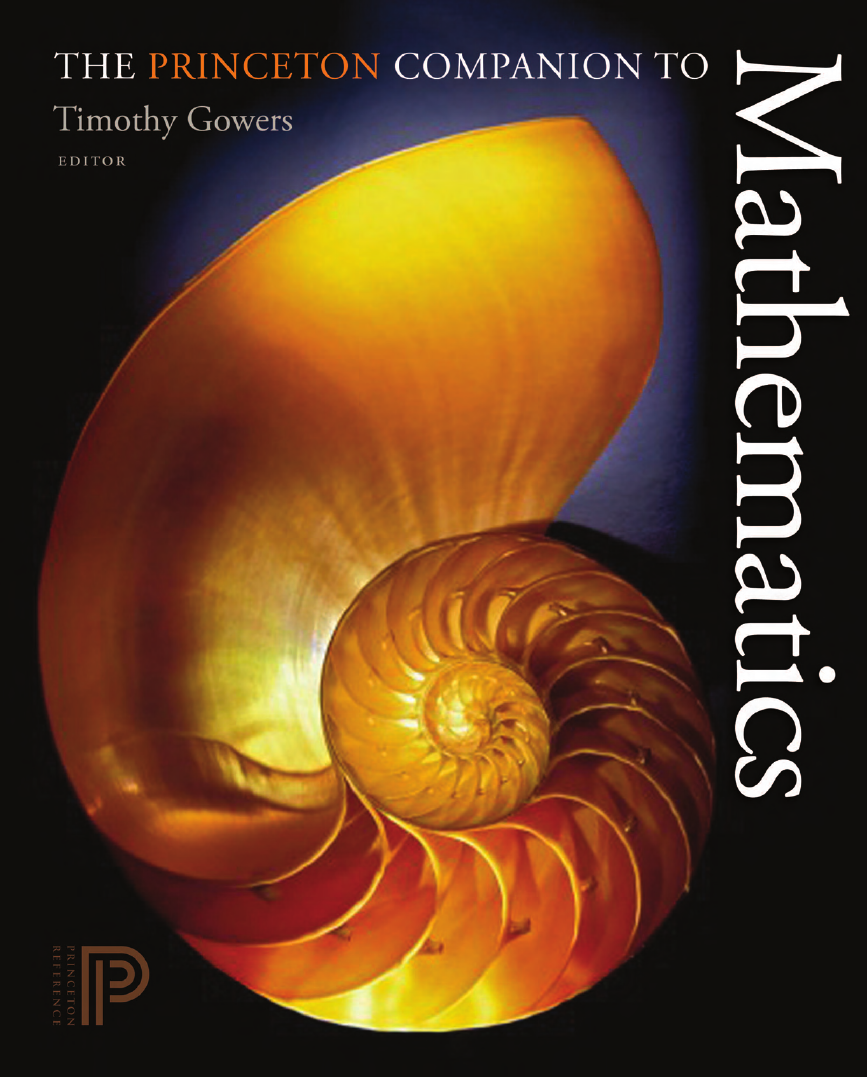
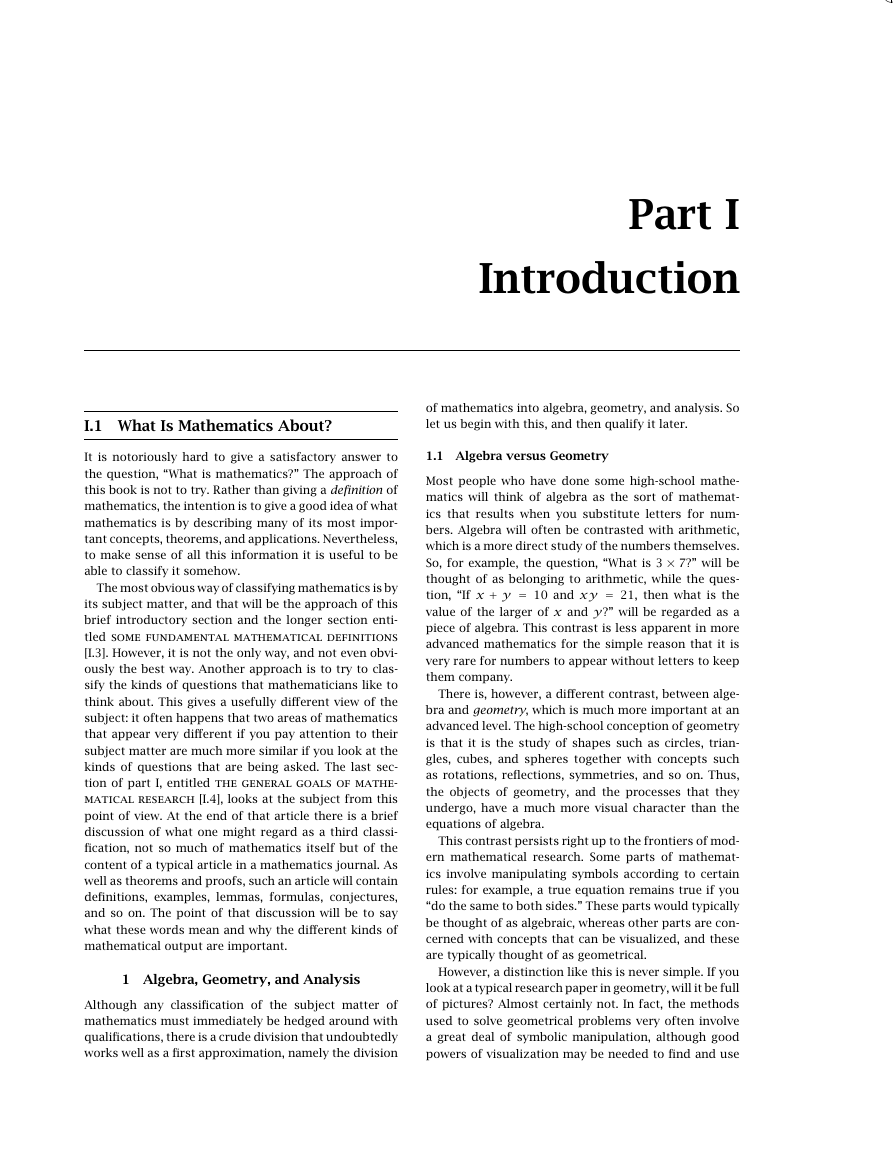
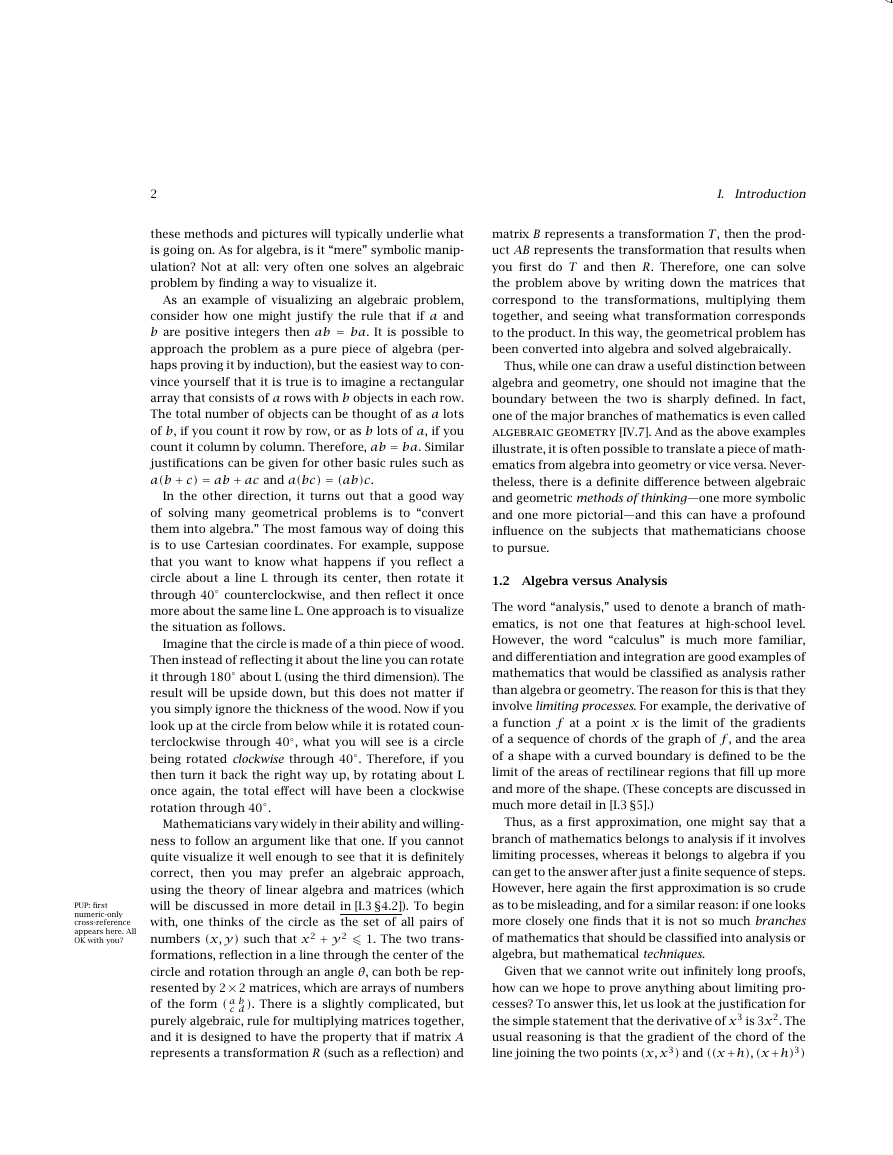
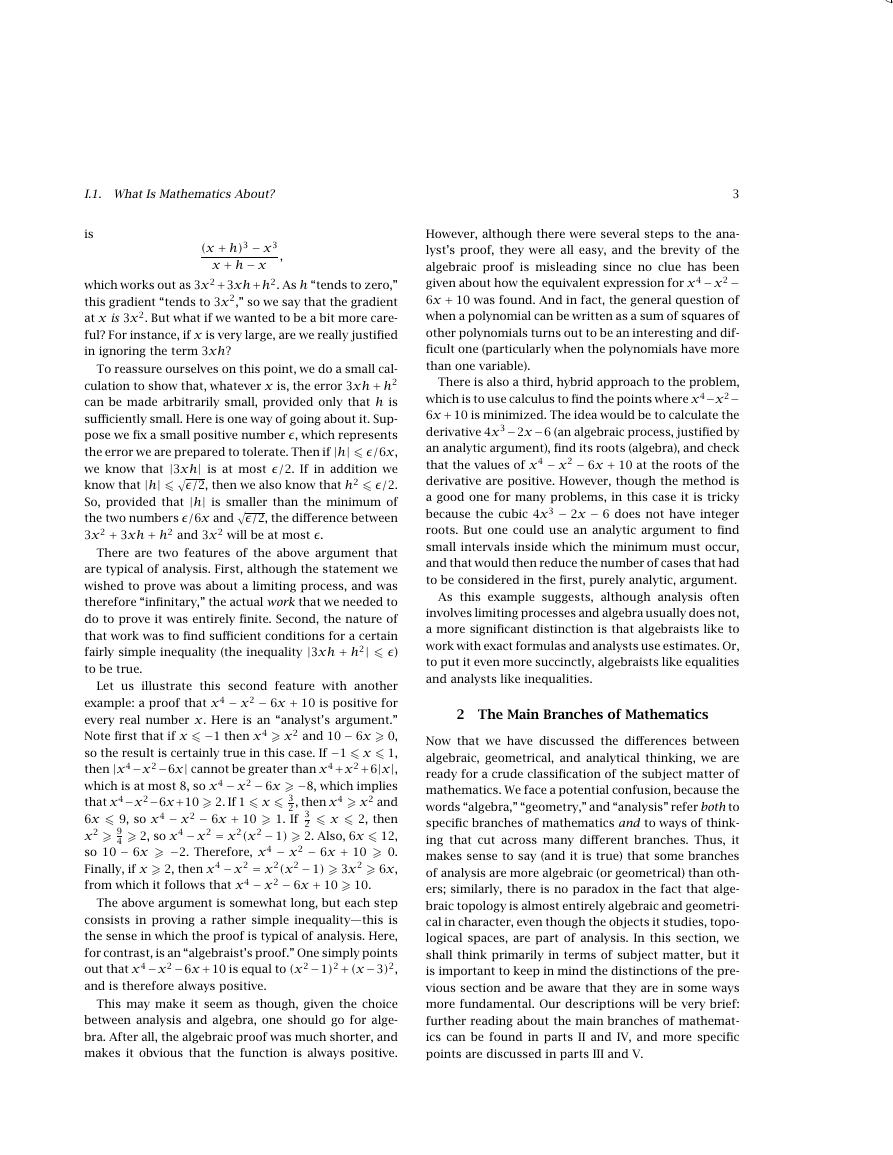
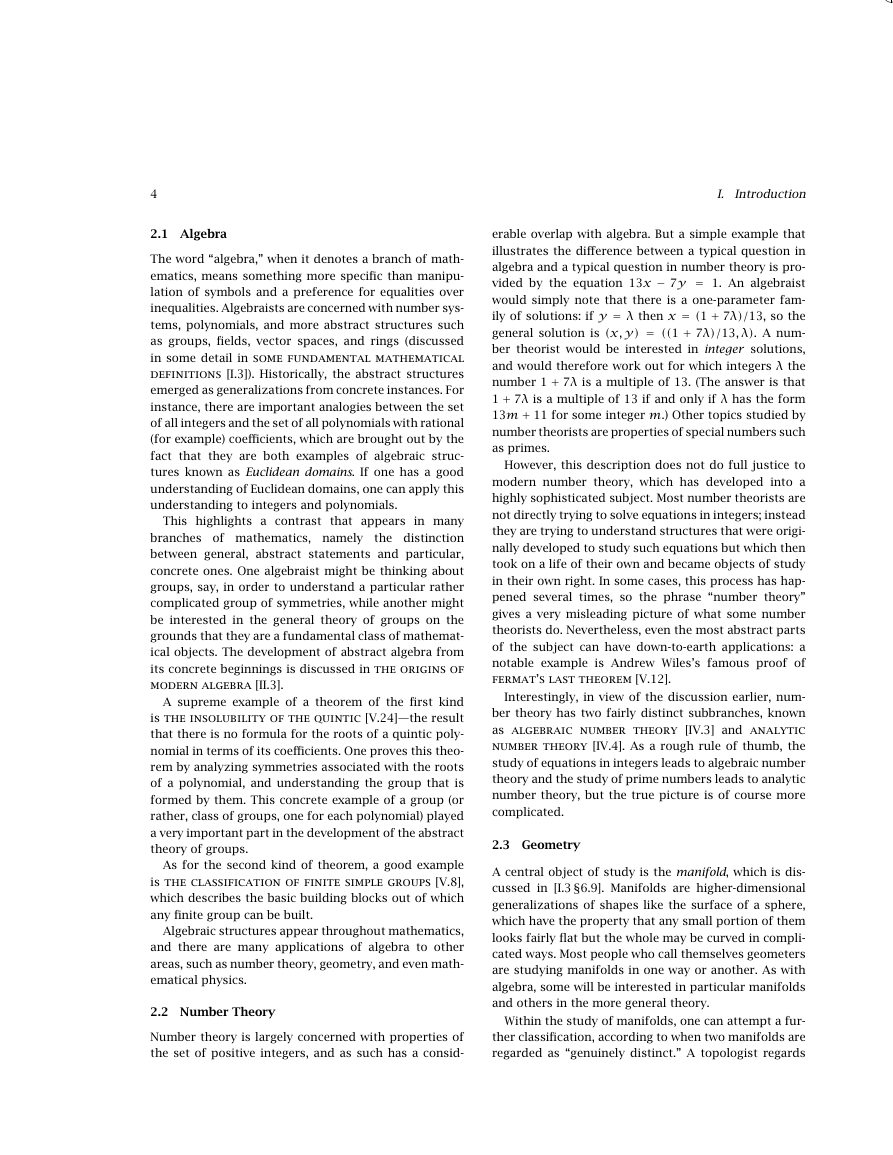

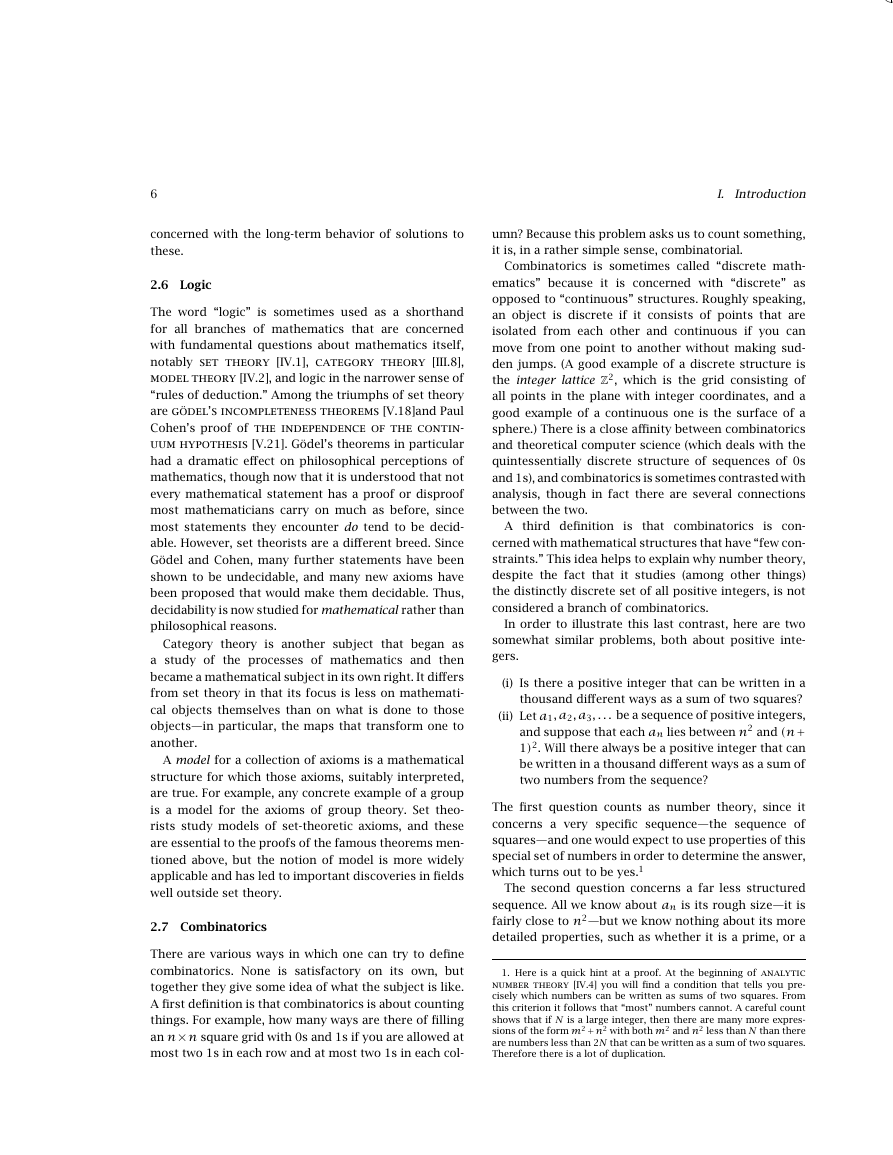
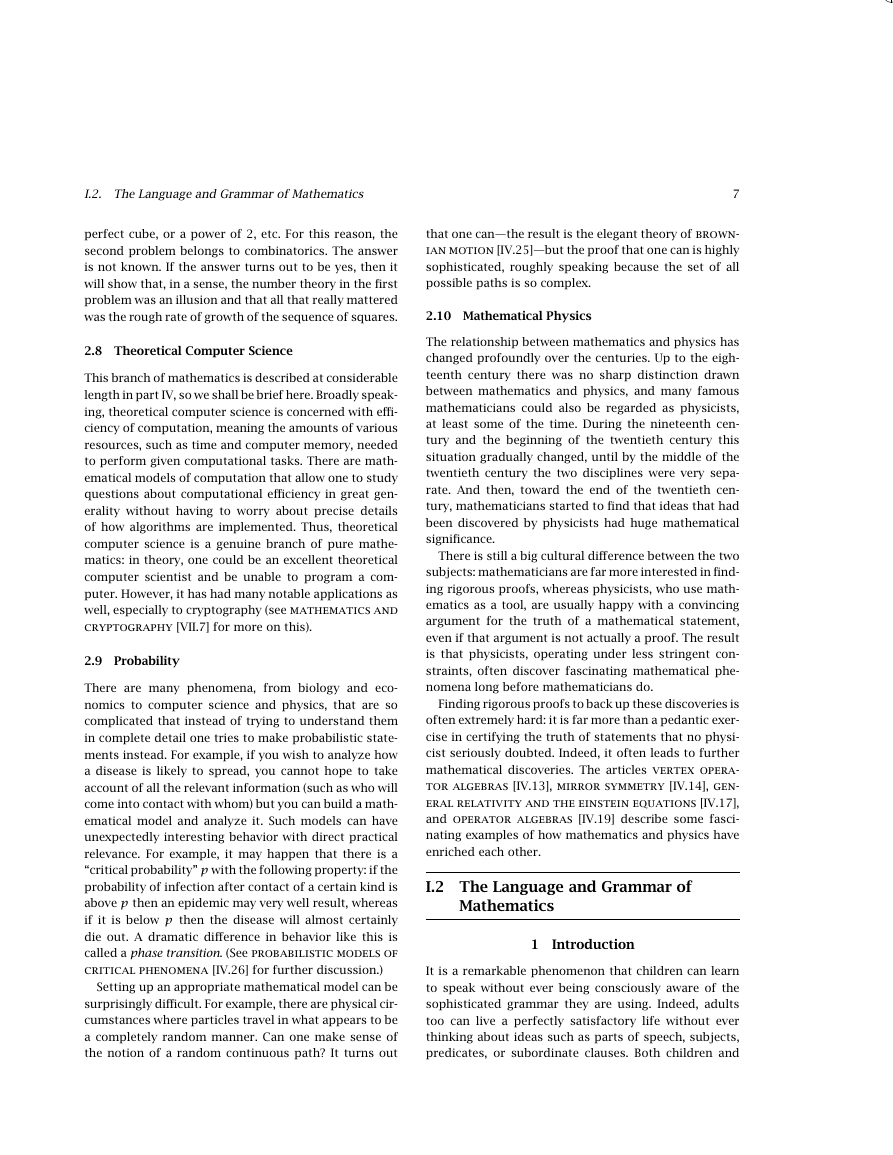








 2023年江西萍乡中考道德与法治真题及答案.doc
2023年江西萍乡中考道德与法治真题及答案.doc 2012年重庆南川中考生物真题及答案.doc
2012年重庆南川中考生物真题及答案.doc 2013年江西师范大学地理学综合及文艺理论基础考研真题.doc
2013年江西师范大学地理学综合及文艺理论基础考研真题.doc 2020年四川甘孜小升初语文真题及答案I卷.doc
2020年四川甘孜小升初语文真题及答案I卷.doc 2020年注册岩土工程师专业基础考试真题及答案.doc
2020年注册岩土工程师专业基础考试真题及答案.doc 2023-2024学年福建省厦门市九年级上学期数学月考试题及答案.doc
2023-2024学年福建省厦门市九年级上学期数学月考试题及答案.doc 2021-2022学年辽宁省沈阳市大东区九年级上学期语文期末试题及答案.doc
2021-2022学年辽宁省沈阳市大东区九年级上学期语文期末试题及答案.doc 2022-2023学年北京东城区初三第一学期物理期末试卷及答案.doc
2022-2023学年北京东城区初三第一学期物理期末试卷及答案.doc 2018上半年江西教师资格初中地理学科知识与教学能力真题及答案.doc
2018上半年江西教师资格初中地理学科知识与教学能力真题及答案.doc 2012年河北国家公务员申论考试真题及答案-省级.doc
2012年河北国家公务员申论考试真题及答案-省级.doc 2020-2021学年江苏省扬州市江都区邵樊片九年级上学期数学第一次质量检测试题及答案.doc
2020-2021学年江苏省扬州市江都区邵樊片九年级上学期数学第一次质量检测试题及答案.doc 2022下半年黑龙江教师资格证中学综合素质真题及答案.doc
2022下半年黑龙江教师资格证中学综合素质真题及答案.doc